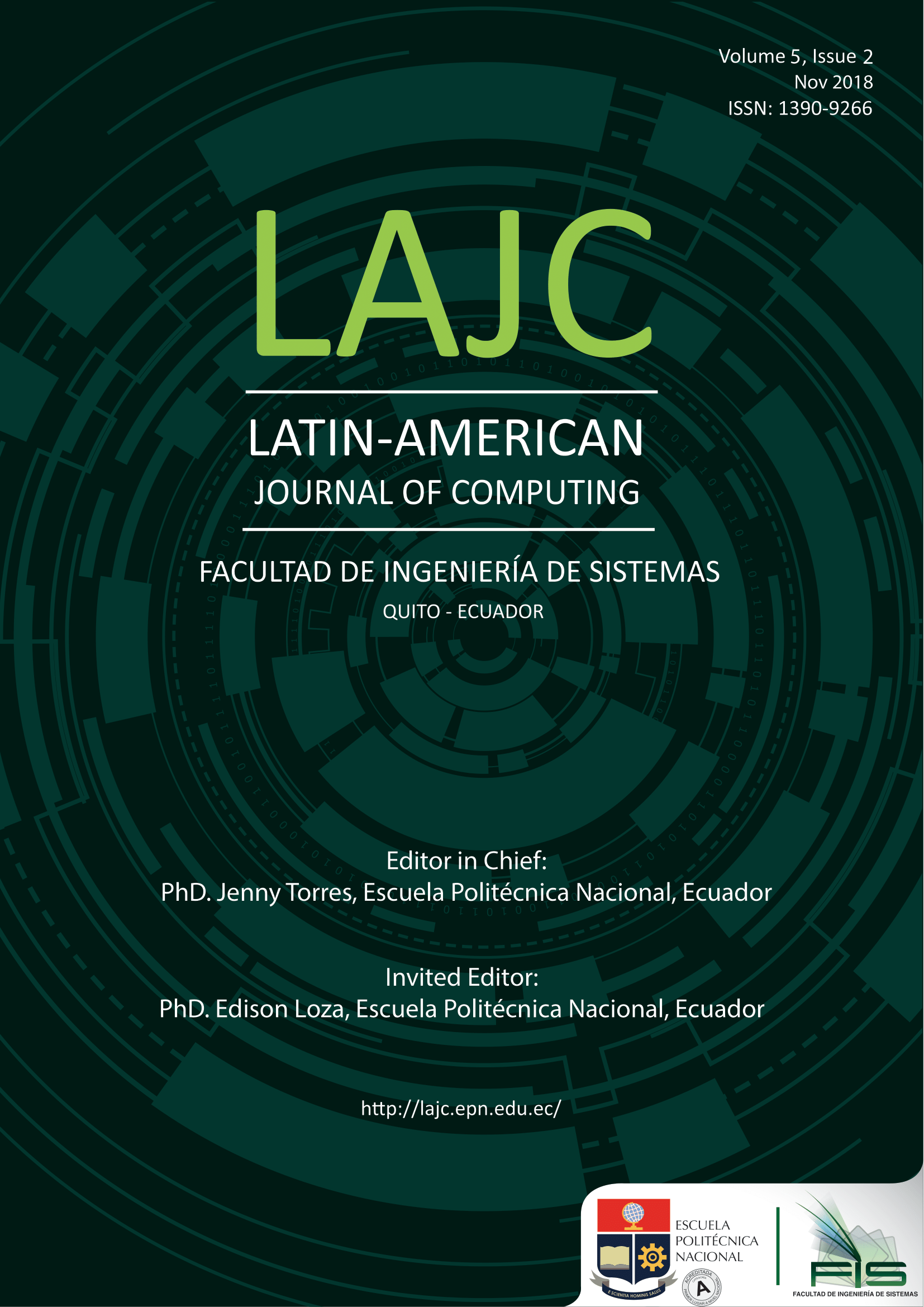Defining architectures for recommended systems for medical treatment. A Systematic Literature Review
Keywords:
Recommender System, Machine Learning, Assisted Medicine.Abstract
This paper presents a Systematic Literature Review(SLR) related to recommender system for medical treatment, aswell as analyze main elements that may provide flexible, accurate,and comprehensive recommendations. To do so, a SLR researchmethodology obey. As a result, 12 intelligent recommendersystems related to prescribing medication were classed dependingto specific criteria. We assessed and analyze these medicinerecommender systems and enumerate the challenges. After studyingselected papers, our study concentrated on two researchquestions concerning the availability of medicine recommendersystems for physicians and the features these systems should have.Further research is encouraged in order to build an intelligentrecommender system based on the features analyzed in this work.
Downloads
References
S. S.-L. Tan and N. Goonawardene, “Internet health information seekingand the patient-physician relationship: a systematic review,”Journal ofmedical Internet research, vol. 19, no. 1, 2017.
R. Sethuram and A. Weerakkody, “Health information on the internet,”Journal of Obstetrics and gynaecology, vol. 30, no. 2, pp. 119–121,2010.
Y. Bao and X. Jiang, “An intelligent medicine recommender systemframework,” inIndustrial Electronics and Applications (ICIEA), 2016IEEE 11th Conference on. IEEE, 2016, pp. 1383–1388.
K. Miller and G. Mansingh, “Optipres: a distributed mobile agent deci-sion support system for optimal patient drug prescription,”InformationSystems Frontiers, vol. 19, no. 1, pp. 129–148, 2017.
I. Nunes and D. Jannach, “A systematic review and taxonomy of expla-nations in decision support and recommender systems,”User Modelingand User-Adapted Interaction, vol. 27, no. 3-5, pp. 393–444, 2017.
S. K. Thangavel, P. D. Bkaratki, and A. Sankar, “Student placementanalyzer: A recommendation system using machine learning,” inAd-vanced Computing and Communication Systems (ICACCS), 2017 4thInternational Conference on. IEEE, 2017, pp. 1–5.
F. Ricci, L. Rokach, and B. Shapira, “Recommender systems: introduc-tion and challenges,” inRecommender systems handbook.Springer,2015, pp. 1–34.
R. Burke, “Hybrid recommender systems: Survey and experiments,”User modeling and user-adapted interaction, vol. 12, no. 4, pp. 331–370,2002.
F. Alyari and N. Jafari Navimipour, “Recommender systems: A system-atic review of the state of the art literature and suggestions for futureresearch,”Kybernetes, vol. 47, no. 5, pp. 985–1017, 2018.
B. Kitchenham, “Procedures for performing systematic reviews,”Keele,UK, Keele University, vol. 33, no. 2004, pp. 1–26, 2004.
B. Yoosooka and S. Chomchaiya, “Medication recommender system,”inScience and Technology (TICST), 2015 International Conference on.IEEE, 2015, pp. 313–317.
A. Dubovitskaya, T. Buclin, M. Schumacher, K. Aberer, and Y. Thoma,“Tucuxi: An intelligent system for personalized medicine from individ-ualization of treatments to research databases and back,” inProceedingsof the 8th ACM International Conference on Bioinformatics, Computa-tional Biology, and Health Informatics. ACM, 2017, pp. 223–232.
B. Stark, C. Knahl, M. Aydin, M. Samarah, and K. O. Elish, “Better-choice: A migraine drug recommendation system based on neo4j,” inComputational Intelligence and Applications (ICCIA), 2017 2nd IEEEInternational Conference on. IEEE, 2017, pp. 382–386.
Y. Zhang, D. Zhang, M. M. Hassan, A. Alamri, and L. Peng, “Cadre:Cloud-assisted drug recommendation service for online pharmacies,”Mobile Networks and Applications, vol. 20, no. 3, pp. 348–355, 2015.
Y. Zhang, M. Chen, D. Huang, D. Wu, and Y. Li, “idoctor: Personalizedand professionalized medical recommendations based on hybrid matrixfactorization,”Future Generation Computer Systems, vol. 66, pp. 30–35,2017.
A. Wang, H. Lim, S.-Y. Cheng, and L. Xie, “Antenna, a multi-rank, multi-layered recommender system for inferring reliable drug-gene-disease associations: Repurposing diazoxide as a targeted anti-cancer therapy,”IEEE/ACM Transactions on Computational Biology andBioinformatics, 2018.
J. Zhang, C. Li, Y. Lin, Y. Shao, and S. Li, “Computational drug repo-sitioning using collaborative filtering via multi-source fusion,”ExpertSystems with Applications, vol. 84, pp. 281–289, 2017.
Q. Zhang, G. Zhang, J. Lu, and D. Wu, “A framework of hybrid rec-ommender system for personalized clinical prescription,” inIntelligentSystems and Knowledge Engineering (ISKE), 2015 10th InternationalConference on. IEEE, 2015, pp. 189–195.
R.-C. Chen, Y.-H. Huang, C.-T. Bau, and S.-M. Chen, “A recommenda-tion system based on domain ontology and swrl for anti-diabetic drugsselection,”Expert Systems with Applications, vol. 39, no. 4, pp. 3995–4006, 2012.
N. T. Thonget al., “Intuitionistic fuzzy recommender systems: aneffective tool for medical diagnosis,”Knowledge-Based Systems, vol. 74,pp. 133–150, 2015.
F. Ali, D. Kwak, P. Khan, S. H. A. Ei-Sappagh, S. R. Islam, D. Park, andK.-S. Kwak, “Merged ontology and svm-based information extractionand recommendation system for social robots,”IEEE Access, vol. 5, pp.12 364–12 379, 2017.
R. Burke, “Hybrid web recommender systems,” inThe adaptive web.Springer, 2007, pp. 377–408.
F. F. Tuon, J. Gasparetto, L. C. Wollmann, and T. P. de Moraes, “Mobilehealth application to assist doctors in antibiotic prescription–an approachfor antibiotic stewardship,”The Brazilian Journal of Infectious Diseases,vol. 21, no. 6, pp. 660–664, 2017.
H. Yago, J. Clemente, and D. Rodriguez, “Competence-based recom-mender systems: a systematic literature review,”Behaviour & Informa-tion Technology, pp. 1–20, 2018.
F. F. Tuon, J. Gasparetto, L. C. Wollmann, and T. P. de Moraes, “Mobilehealth application to assist doctors in antibiotic prescription–an approachfor antibiotic stewardship,”The Brazilian Journal of Infectious Diseases,vol. 21, no. 6, pp. 660–664, 2017.
Downloads
Published
Issue
Section
License
Copyright Notice
Authors who publish this journal agree to the following terms:
- Authors retain copyright and grant the journal right of first publication with the work simultaneously licensed under a Creative Commons Attribution-Non-Commercial-Share-Alike 4.0 International 4.0 that allows others to share the work with an acknowledgement of the work's authorship and initial publication in this journal.
- Authors are able to enter into separate, additional contractual arrangements for the non-exclusive distribution of the journal's published version of the work (e.g., post it to an institutional repository or publish it in a book), with an acknowledgement of its initial publication in this journal.
- Authors are permitted and encouraged to post their work online (e.g., in institutional repositories or on their website) prior to and during the submission process, as it can lead to productive exchanges, as well as earlier and greater citation of published work.
Disclaimer
LAJC in no event shall be liable for any direct, indirect, incidental, punitive, or consequential copyright infringement claims related to articles that have been submitted for evaluation, or published in any issue of this journal. Find out more in our Disclaimer Notice.










